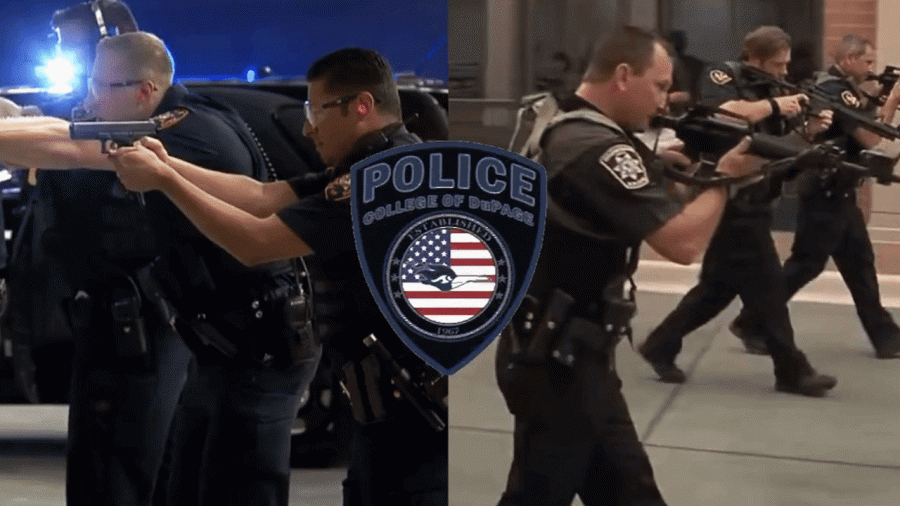MSU Shooting: What It Means For COD
On Feb. 13, a gunman opened fire in two separate buildings at Michigan State University, killing three students and injuring five. How has COD planned to prepare itself against such tragedies?
Police officers train at COD’s tactical firearms range and immersive street scene training centers
February 20, 2023
Editor’s Note: this story uses an anonymous source in order to separate the source from traumatic events, in order to avoid being approached with questions that cause her to relive those memories over and over. The name “Jane” has been assigned to the individual who wishes to remain anonymous. Both the writer and the Editor in Chief know the identity of the source.
Jane, a senior at Michigan State University, had gone to her weekly meeting for a club at the athletics building on campus, less than a mile away from where the shooting had taken place. Around 50 people had showed up to the club meeting that night.
“Someone who was at the meeting said that there was an active shooter towards that area of campus and then a few minutes later we got alerts about it,” Jane said.
Jane and other club members started receiving alerts on their phones that said “run, hide, fight,” and the club meeting turned into something so “surreal.”
“We were in there for four hours, and at first we didn’t really know what to think about it because we’ve gotten alerts before that said there were shots fired, but we didn’t know how serious it was,” Jane said. “As time went on, we got more information about it, and we realized that it actually was a serious situation. People started getting calls from their loved ones. People started crying.”
Fortifications were being put in place, and the entire building went into lockdown mode. One of Jane’s peers decided to stand guard at the door.
“We locked all the doors to the building and put benches and stuff in front of the doors to barricade them,” Jane said. “Then there was someone standing at the doorway with a crowbar. I see this guy all the time when I come to these meetings, so it was really sad that he was in that situation.”
After a press conference from the police, and a text sent to students stating that there was no longer a threat on campus, MSU was officially deemed secure from the active shooting incident. Students walked out to a campus filled with police presence.
“I mean people were very relieved to be able to leave the building, but at the same time the shock doesn’t just go away immediately,” Jane said. “I remember walking to my car and feeling like it was all a dream, but then you see the helicopter and police cars.
“There were cars everywhere, and parents running around trying to find their kid,” Jane said. “It was just shocking how many vehicles were there. You could barely even get through the street.”
The MSU community has aimed to provide numerous support services in the wake of the violent acts committed on campus. Group therapy, crisis counselors and a 24/7 support number are some of the resources available.
“I do think that there’s a really strong sense of community right now, which is nice,” Jane said. “There’s a lot of compassion. A lot of people coming together and supporting one another.”
According to a USA Today report, since the beginning of 2023, 71 mass shootings have occurred across the United States. When the police department at COD got wind of what had happened at MSU, officers were reminded of a tragedy they pray never strikes COD’s campus.
“I hate to say it, but our reaction every time is the same. It’s, ‘Oh God not again, and thank God it’s not here,’” Joseph Mullin, chief of police for COD’s police department, said. “We’ve seen this in the news so many times. Obviously this is the kind of thing that keeps us up at night. It’s tragic. It’s wasteful. It’s kind of a nightmare for us.”
The police department continues to wait for a detailed account that describes the specifics on how the shooting transpired at MSU.
“No one knows what happened until you get the after-action report months later, and that’s what we wait for, because in that after-action report we hope there’s something we can learn,” Mullin said. “From the investigations, we try and piece those [together] to see if there’s anything we would have done differently, that we could have done differently, and what can we implement so that we’re not the next one.”
A lot of Lieutenant Kent Munsterman’s role at the COD police department focuses on illustrating emergency preparedness for everyone at the college. Students can search “College of DuPage police department” for resources that are meant to prepare oneself in dealing with a wide array of violent situations.
“The first is making prevention a reality. It’s a class all about recognizing warning behaviors, risk factors, leakage,” Munsterman said. “Then we have active violence preparedness. That was transitioned to a video that is available online. Then there’s active violence preparedness phase two, which is hands-on, where participants can execute strategies behind run-hide-fight.”
Munsterman said these active violence preparedness classes are all voluntary courses. A student must decide to sign up and learn these techniques. Faculty and staff at COD are given some form of required active violent preparedness training, but students are not.
“I don’t know that we have tried to implement something that was mandatory, because that’s not our call,” Mullin said. “We obviously have had in-depth conversations with the administration about how to reach students and what trainings we would like to make available to them, but it’s very difficult when you talk about mandates.”
Run-hide-fight is a safety protocol that has been implemented nationwide to prepare people in all kinds of institutions for an active shooter situation.
“Your priority is to run. Your priority is to evacuate, if you can. If it’s safe to do so, evacuate, get out,” Munsterman said. “If you cannot viably get out because the threat is too close to your proximity, you’d want to hide. You kind of want to improve your situation by barricading doors and fortifying your position, creating a difficult situation for the threat to potentially gain access to your location. If you can’t run, you can’t hide, and that threat is coming to your location right now, you have to fight.”
Munsterman sits on the Behavioral Intervention Team (BIT) at COD, whose mission is to maintain a safe environment across all COD campuses. The team has an online referral form where anyone who submits it can refer an individual who needs assistance.
“It’s a multidisciplinary team. It consists of 12 different members, and we meet once a week. We discuss incidents that are referred to the team that are of concern,” Munsterman said. “If somebody would exhibit a concerning or threatening behavior, the team would assess those behaviors and come up with an intervention to get the person the best help through whatever situation or crisis they’re experiencing.”
For violence that does end up happening on campus, the police department ensures response time will be as instantaneous as possible. Students should download the mobile safety app “Rave Guardian,” available on iOS and Android, where users can submit tips, enable their location to be monitored and receive safety alerts from campus police.
“We’re here 24/7, and as soon as we’re made aware of it we’ll be moving to address the threat,” said Mullins. “At the same time, we have a Rave Alert System, and we’ll be using whatever notification systems in addition to that in the buildings that might be available to us.”
The response time from COD’s police department will be immediate, but because of many uncontrollable variables, prevention can only go so far.
“If it happens here today and one person loses their life, it’s too many, but I can’t say there’s no chance of that happening here,” Mullins said. “I mean, I pray to God it never happens, and we work every day to try and ensure that it doesn’t, but we’ve seen the randomness of it. I don’t know how you answer that.”
The police department will be giving active violence preparedness training in the Homeland Security Education Center from 2 to 4 p.m. on Monday, March 30 and 9 to 11 a.m. on Thursday, June 3 in HEC 1009.
Staff Writer Antonio Llanos contributed to the gathering of information for this article.


















